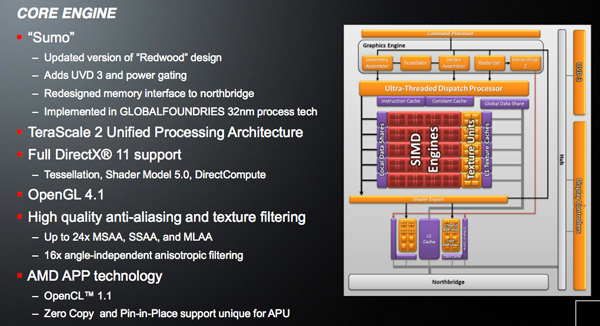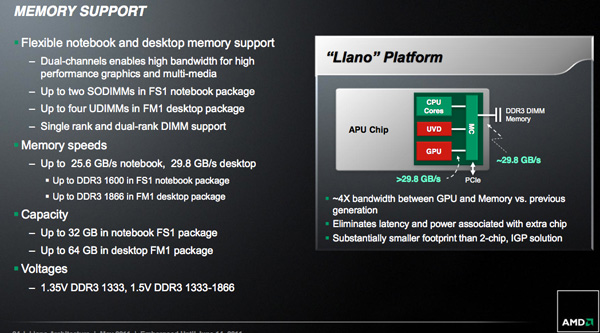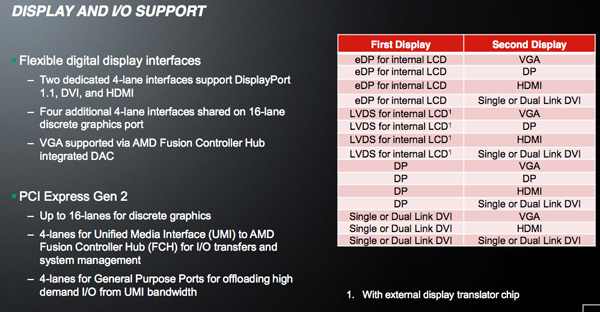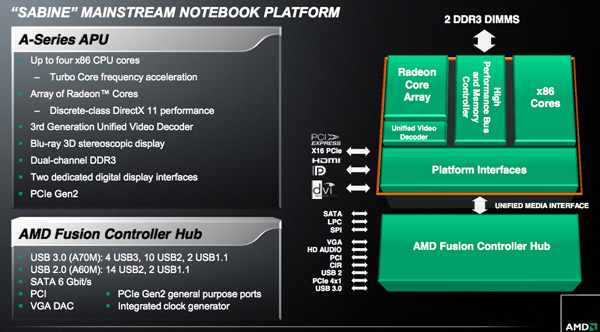The AMD Llano Notebook Review: Competing in the Mobile Market
by Jarred Walton & Anand Lal Shimpi on June 14, 2011 12:01 AM ESTThe GPU
While the Llano CPU cores may be in need of a major overhaul, Llano's GPU is as new as it gets. Technically based off of AMD's Redwood core (Radeon HD 5570) with some enhancements, Llano's GPU is codenamed Sumo.
The DX11 GPU features five SIMD arrays, each with 80 cores for a total of 400 shader processors. Similar to the updates we saw with this year's Northern Islands GPUs, Sumo does add UVD3 support to the Redwood architecture. Of course since Sumo shares the same die as the Llano CPU cores it is built on GlobalFoundries' 32nm process, making this the first AMD GPU fabbed at GlobalFoundries and not TSMC.
For everything behind the memory controller Sumo is virtually identical to Redwood. Where Sumo differs is in its memory interface. Although Llano is AMD's first performance oriented APU, it's still constrained by a 128-bit wide DDR3 memory interface. That dual-channel memory interface has to be shared by all four Llano cores as well as the Sumo GPU and as a result, arbitration is very important.
AMD shared a few choice details about the Llano memory controller architecture. To begin, AMD guarantees more than 30GB/s of bandwidth is available between the GPU and the memory controller—in other words, the path from GPU to the memory controller won't become a bottleneck. The GPU/memory controller link (i.e. within the APU die) can apparently scale up to as much as 50GB/s to support future APUs with even faster memory interfaces. Note that unlike previous integrated graphics solutions, there is no support for dedicated external memory—this is a pure shared memory architecture.
Second, and most importantly, AMD can dynamically prioritize memory bandwidth between the CPU and GPU. In most cases, when both processors are heavily consuming data, the GPU is given priority over the CPU. Given today's workloads, prioritizing the GPU for memory accesses makes sense when it's running full tilt. The chances of you stressing all four CPU cores and running at full GPU memory bandwidth requirements are pretty slim today.
With 400 shader processors behind a shared 128-bit DDR3 memory interface, the upper bound for Sumo performance is the Radeon HD 5570. In practice, you should expect performance to be noticeably lower since the GPU does have to share its precious memory bandwidth with up to four x86 CPU cores.
The mobile version of Llano supports up to DDR3-1600 while the desktop parts can run at up to DDR3-1866. Maximum memory capacities are 32GB and 64GB for notebooks and desktops, respectively.
Llano has a total of 24 PCIe Gen 2 lanes at its disposal. Sixteen of those lanes can be used for external graphics. Four of the lanes can be used for devices that need low latency/high bandwidth access to the APU itself (e.g. Gigabit ethernet). The remaining four lanes are used to connect the APU to its sole partner in crime: the Fusion Controller Hub.
AMD is particularly proud of the display output configurations supported by Llano. The possible combinations are listed below:
Chipsets
AMD will offer two Fusion Controller Hubs (FCHs) as options for Llano: A70M and A60M. The only difference between the two is in their support for USB 3.0; the A70M has four USB 3.0 ports while the A60M has none.
Both FCHs support 6Gbps SATA and perform just as well as AMD's 8-series chipset (or Intel's Z68) with a high performance SSD. USB 3.0 performance is also comparable to 3rd party solutions we've seen deployed on motherboards already.















177 Comments
View All Comments
JarredWalton - Tuesday, June 14, 2011 - link
Totally agree with the pricing. The highest performance A8 laptops are going to need to be $700 with fGPU only, and maybe $800 with dGPU, because that's where dual-core i5 + Optimus laptops are currently sitting.Of course, I'd still pay more for good build quality and a nice LCD and keyboard.
Oh, and the people saying CPU is the be-all, end-all... well, even though I have a couple Core i7 Bloomfield systems in my house (and many Core i5/i7 laptops), my primary work machine is running... Core 2 QX6700 (@3.2GHz) with an HD 5670 GPU and 4GB RAM. The area I want to upgrade the most is storage (currently using RAID0 Raptor 150GB), but I have no desire to reformat and start transferring apps to another PC, so I continue to plug along on the Raptors. This CPU is now over four years old, and yet the only thing I really don't like is the HDD thrashing and slow POST times.
ionave - Thursday, June 16, 2011 - link
None of those GPU's match the power of the 6620, which you can find in even the A6 series, so your point is invalid.Dribble - Wednesday, June 15, 2011 - link
Actually you can normally tell quite easily which laptop has the slower cpu. It's the one with the fan whining away. With laptops having a more powerful processor that isn't having to work so hard is important just to keep the thing quiet.As for cpu power - well windows and it's software just isn't that efficient. Even a fairly complex word 2010 doc (few pictures/charts/etc) can start to feel slow on a 2.5Ghz C2D (I should know my laptop has a 2.4Ghz C2D). The flash games my kids seem to be forever finding are also cpu only and will run it flat out and the game won't seem as smooth as it would on a faster machine.
Sure you can get by with a slower machine, but it doesn't make for such a pleasant experience.
It has been the case since PC's arrived that over time software needs more and more power. e.g. I could run word 6 on a 486, I now really need a dual core 2Ghz machine to even run word 2010. I don't see that changing hence the faster your cpu the longer your pc will remain usable.
lukarak - Wednesday, June 15, 2011 - link
I've been using a 2007 tech MacBook white up until a few months ago with a 2.0 GHz C2D. Over time i upgraded it to include 6 GB of memory, a 64 GB SSD + 500 GB HDD, and then i transitioned to a 2011 MPB 13 with a SNB CPU and 4 GB of memory. Aside from a better screen, once i put in the SSD, i couldn't see the diference in speed. I usually use a lot of VM, use Eclipse and XCode, and most of the time watch 720p and the more than 3 years newer CPU isn't all that revolutionary. Sure, it may not use 30ish % of the CPU to play movies, but only 20ish, but until that's 50ish% when the fan gets louder it doesn't really matter for me.ionave - Thursday, June 16, 2011 - link
The CPU looks relatively slow to the i5/i7, but its really not that slow. Seriously. Compare it to an atom and see that its not that bad.ionave - Thursday, June 16, 2011 - link
The CPU isn't even bad. I don't know what you guys are all on but A8 cores are improved phenom II x4 cores... I would say its about the same performance as the i5 series. All the benchmarks online are measured on the WORST A8 chip, which has the worst CPU performance. All of the reviews are on A8-3500M. Just wait until the A8-3850 gets benchmarked.All I'm saying is that its not fair to compare the worst A8 to the best i5 or best i7, plain and simple.
sundancerx - Tuesday, June 14, 2011 - link
for most of the charts, yellow bar is assigned to INTEL asus k53e(i5-2520m+hd3000), but on asymetrical crossfire, this is assigned to AMD llano (18-3500m+crossfire). kind of confusing if you dont pay attention or am i the one confused?JarredWalton - Tuesday, June 14, 2011 - link
Dark yellow = K53E, bright yellow = CrossFire. If you have a different color you think would work, I'll be happy to change it. Purple? Brown? Orange?adrien - Tuesday, June 14, 2011 - link
I agree Brazos looks less interesting now but it still has one huge advantage: price. If Llano notebooks are going to sell for $600 (or $500), Brazos are 40% less expensive.JarredWalton - Tuesday, June 14, 2011 - link
Brazos E-350 (which is already 60% faster than C-50) start at around $425. They come with 2GB RAM and a 250GB HDD. AMD is saying $500 as the target price for A4, $600 for A6, and $700 for A8, but I suspect we'll see lower than that by at least $50. So if your choice is Brazos E-350 for $425 or Llano A4 for $450, and the Llano packs 4GB RAM and a 500GB HDD, there's no competition--though size will of course be another factor. I figure Llano will bottom out at 13.3-inch screens where Brazos is in 11.6" and 12.1". Personally, I'd never buy a 10" netbook; I just can use them comfortably. I'm happiest with 13.3" or 14" laptops.